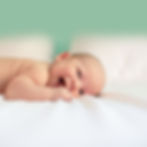Cradle Cap: Understand and Treat It!
- Molly Levin Rouse
- Jul 26, 2021
- 3 min read
Grooming our young is something we share with all primates. It is so satisfying to clean out earwax, belly button lint, sleepy seeds in the corners of the eyes, anything hiding in the beautiful fat rolls on a baby’s wrists and thighs, etc. However there is nothing like cradle cap – the flaky/oily/scaly stuff on the top of a baby’s head – to bring out these maternal urges to pick at things on our babies full force. When my first baby was an infant, in 2007, I spent hours holding him and slowly removing each scaly bit of cradle cap with my fingernail. Since then, I have learned more about cradle cap and how to get rid of it efficiently.

So what is cradle cap? It is an incredibly common, unsightly, yet harmless breakout of flakiness on a baby’s head. It is REALLY NOTHING TO WORRY ABOUT! Most mothers just want to make it go away lest our babies look dirty, sick, or reptilian. The good news is that gently removing it (see suggestions below) usually does the trick and it doesn’t pose a problem again. The medical term for cradle cap is infantile seborrheic dermatitis. It is a skin irritation found in oily places, and is very common in babies less than 6 months old. I want to reiterate that CRADLE CAP USUALLY DOESN'T COME BACK AFTER REMOVAL. However, if it is returning to your baby’s scalp after you have used the gentle method below to remove it - OR if the scalp is sensitive, inflamed, or infected - the following things might be underlying issues and you should consult a health care professional: · Imbalanced gut microbiome – This is common if you or your baby were given antibiotics during or after delivery, or afterwards. Babies born via caesarean are also susceptible to gut imbalance, as they didn’t get inoculated with mom’s flora and fauna by going through the birth canal. Probiotics can help. · Suppressed immune system - If a baby has other health challenges, cradle cap is more likely to occur. Breastfeeding or giving your baby donor milk are the best remedies. · Nutritional deficiencies – a lack of certain vitamins and minerals contribute to cradle cap. If you are breastfeeding, make sure you are eating a varied diet and taking supplements as needed; if not, talk with your pediatrician about supplements for your baby. · Elevated maternal hormones - Some believe that a mother’s hormones in late pregnancy can cause over-secretion of oil glands in the skin that facilitates the clogging of the pores in the skin with dead cells as the baby shifts to making their own hormones.

Molly’s Gentle and Safe Cradle Cap Treatment I have found that the best way to get cradle cap off is with oil and gentle abrasion. I love coconut oil because it is antifungal and antibacterial, so if yeast or other bacteria are present, it helps get rid of them too! (You can add a drop of tea tree essential oil to the total amount of coconut oil that you are using in order to have added antibacterial/fungal power!) Step 1: Massage a generous amount (but not so much that it drips) of coconut oil into all areas of your baby’s head affected by cradle cap. Alternatives: olive oil, almond oil, avocado oil, or breastmilk. Step 2: Let the oil sit for a 5-20 minutes – the longer the better. Step 3: Using a soft-bristled baby brush, scrub at the cradle cap flakes. They should peel off fairly easily without discomfort for your babe. Alternative: if you don’t have a brush, you can use a dry rough washcloth, or a plastic comb to gently scrape at the scales. Step 4: After removing cradle cap flakes, massage remaining oil into your baby’s scalp or wipe it off with a warm washcloth and mild soap. Step 5: Repeat as needed to remove all cradle cap.
If there is any sign of infection or irritation with this process, or you have questions about your baby's cradle cap, please contact your health care professional.
Best of luck to you as you embrace you primal natural and get rid of cradle cap! May you then turn your attention to other ways of taking care of your beautiful new baby.
___________________________________________________________
Life Beyond Birth provides support for expectant parents, and new babies & their families, online and in-person. Find a class or contact Molly at www.lifebeyondbirth.com.
